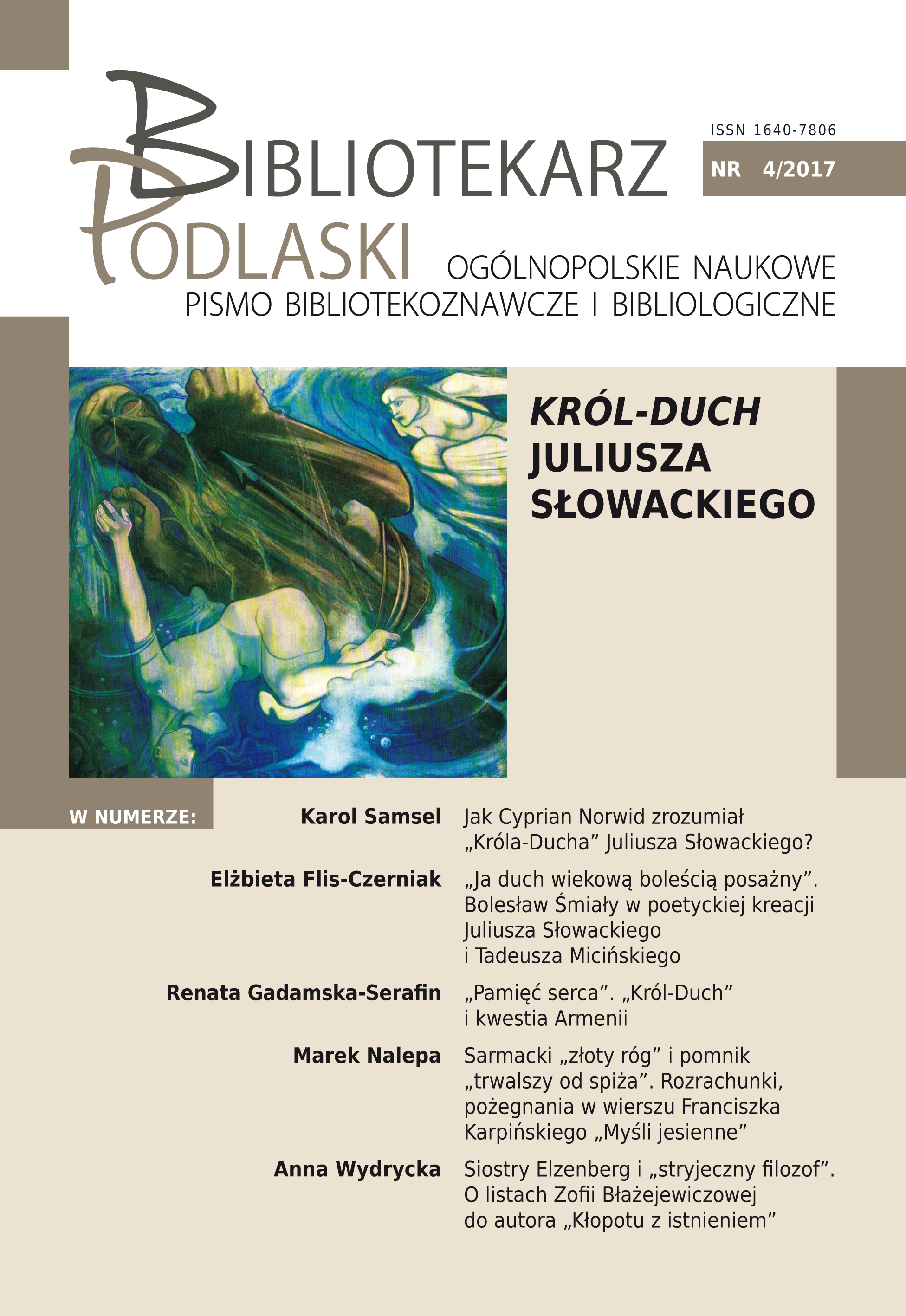Abstract
The subject matter of the study is the Armenian theme woven into "The Spirit-King", which is linked both to Juliusz Slowacki’s biography and the main hero of his epos – Hera Armenian. The findings of contemporary Armeniologists and Iraniologists irrefutably show the Armenian basis of the myth of Hera, the son of Armenios, quoted by Plato in his 10th book of The Republic (Politeia) and artistically transformed in Slowacki’s work (contrary to the assumptions by Polish literary scholars who considered Hera’s Armenianness to be a mistake made by the French translators of The Republic).The myth’s source lies in the Armenian story of Ara the Beautiful, slightly modified under the influence of Persian (Iranian) culture and religious tradition, particularly that of Zoroastrianism. The figure of Hera-Zarathustra evokes the Romantic concepts of the Iranian ethnogenesis of Slavs in Slowacki’s Slavonic epic. The context of the “Iranian thesis” allows us to regard "The Spirit-King" not only as a monument of Latin civilization or a reservoir of Scandinavian mythology, but also as a Romantic gate to the Orient, revealing (thanks to Plato) the forgotten tangled web of Slavonic, Iranian and Armenian prehistory. The Romantic “discernment of one’s nature” in Slowacki’s work happens through the exploration of the deepest layers of the collective memory of the Indo-Europeans (particularly Slavs) and (possibly) by searching one’s own oriental roots. In this sense, "The Spirit-King" becomes a record of a Romantic “memory of the heart”.
References
Barącz S., Rys dziejów ormiańskich, Tarnopol 1869.
Barseghian B., Juljusz Slowacku arjan kancz-y, haj jew leh Arka-Wokin (Zew krwi. Ormiański i polski „Król-Duch”), Erewań 2012.
Barseghian B., Juliusza Słowackiego zew krwi, przeł. J. Szokalski, „Biuletyn Ormiańskiego Towarzystwa Kulturalnego” 2013, nr 72/73, s. 43-47.
Boré E., L’univers pittoresque ou l’histoire et description de tous les peuples Russie, Paris 1838.
Cochran P., The serpent bites the file: Byron and the Armenians, http://www.newsteadabbeybyronsociety.org/works/downloads/byron_armenians.pdf
Dawid z Sasunu, przeł. I. Sikirycki, Warszawa 1983.
Dowling G., In Venice and in the Veneto with lord Byron, Venezia 2008.
Encyclopedia of Armenian Culture, Institute for Armenian Studies of Yerevan State University, http://www.armeniaculture.am/en/Encyclopedia_hay_mshakuyti_hanragitaran (9 X 2016).
Euzebiusz z Cezarei, Praeparatio Evangelica, przeł. E. H. Gifford, London 1903, http://www.tertullian.org/fathers/eusebius_pe_13_book13.htm (9 X 2016).
Kleiner J., Objaśnienia wydawcy, [w:] J. Słowacki, Dzieła wszystkie, pod red. J. Kleinera, t. VII, Lwów 1930.
Klemens Aleksandryjski, św., Kobierce zapisków filozoficznych dotyczących prawdziwej wiedzy, przeł. i wstępem opatrzyła J. Niemirska-Pliszczyńska, t. 1-2, Warszawa 1994.
Lisicjan S., Z przeszłości Armenii. Legendy, baśnie, opowieści, przeł. A. Pisowicz, Warszawa 2014.
Lord Byron and the Armenians, Venezia 1983.
Lord Byron’s Armenian exercises and poetry, Venice 1870, https://archive.org/details/lordbyronsarmeni01byro.
Mathorez J., Les Arméniens en France de 1789 à nos jours, „Revue des Etudes Arméniennes”, Paris 1922, s. 293-314, http://www.globalarmenianheritage-adic.fr/fr/6histoire/par_pays/france019ecolesparis.htm (9 X 2016).
Moїse de Khorène, Histoire d’Arménie, text armenien et traduction française, avec notes explicatives et précis historiques sur l’Arménie par P. E. le Vaillant de Florival, Paris 1845,
http://reader.digitale-sammlungen.de/en/fs1/object/display/bsb10250133_00013.html (9 X 2016).
Peratoner A., Dall’Ararat a San Lazzaro. Una culla di spiritualità e cultura armena nella laguna di Venezia, Congregazione Armena Mechitarista, wyd. 2, Venezia 2015.
Pisowicz A., Między Herem Armeńczykiem a Kurdem (!) o imieniu Kirkor, „Ruch Literacki” R. LVI: 2015, z. 1 (328), s. 61-75.
Russel J, The Platonic Myth of Er, Armenian Ara and Iranian Ardāy Wīrāz, [w:] Armenian and Iranian Studies, pod red. J. Russela, New York 2004, s. 21-29.
Sayegh A., „Genetyczna pamięć” w twórczości wielkiego Juliusza Słowackiego, „Awedis” 2013, nr 16, s. 10, http://www.ormianie.pl/files/Awedis_2013_16.pdf (9 X 2016).
Skarbnica wiedzy o polskich Ormianach, http://www.skarbnica.ormianie.pl/?id=11 (9 X 2016).
Słuszkiewicz E., Literatura ormiańska, Warszawa 1991.
Surowiecki W., Śledzenie początku narodów słowiańskich, Warszawa 1824.
Talko-Hryncewicz J., Juliusz Słowacki jako typ antropologiczny, „Przegląd Antropologiczny” 1928, t. III, z. I-II, s. 12-40.
Tatara M., Historia, mit i baśń w „Królu-Duchu”, [w:] tegoż, Od Kochanowskiego do Norwida. Lektury i rozprawy, Kraków 2007, s. 219-238.
Vangelista M., Lord Byron in the Armenian Monastery in Venice, https://byronico.com/2013/09/04/lord-byron-in-the-armenian-monastery-in-venice/.
Wirtualne archiwum polskich Ormian, http://www.archiwum.ormianie.pl/ (9 X 2016).
Articles published in the “gold open access” mode on the basis of a non-exclusive license agreement between the publisher and the author. Permitted use:
- the publication may be read and stored on any device,
- the publication may be cited (with obligatory reference to the author, the title of the text, as well as the full title, bibliographic address of the issue and page of the journal)
The editorial team of “Bibliotekarz Podlaski” implements an open access policy by publishing materials in the form of the so-called Gold Open Access. From volume 42 (issue 1/2019), the journal is available under the Creative Commons license (Attribution – ShareAlike: CC BY-SA).
The key declarations of the Open Access and Open Science movement, which we fully support, are available on the CEON Open Science website.
COPYRIGHT:
The editorial team of “Bibliotekarz Podlaski” implements an open access policy by publishing materials in the form of the so-called Gold Open Access. The journal is available under the Creative Commons license – Attribution – ShareAlike 4.0: International: CC BY-SA 4.0).
The key declarations of the Open Access and Open Science movement, which we fully support, are available on the CEON Open Science website.
“Bibliotekarz Podlaski” allows its readers to read, download, copy, distribute, print, search and link to the full content of articles. We enable full, immediate, unlimited (both in a territorial, temporal and technical sense) open access to all published content, in accordance with the principle that freely available research increases and accelerates the global development of science and the exchange of knowledge.
The editorial team of “Bibliotekarz Podlaski” encourages authors to place articles published in the journal in open repositories (after the review or the final version of the publisher), provided that a link to the journal’s website is provided.
The journal does not charge the authors any fees for accepting and publishing their texts.


